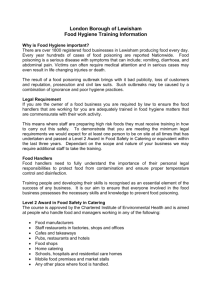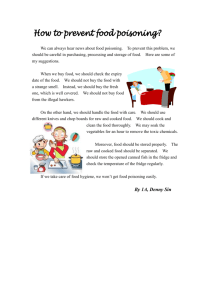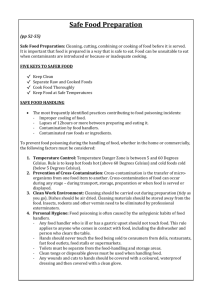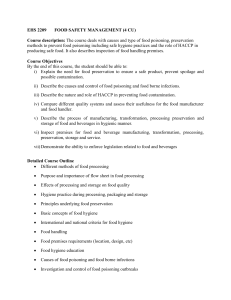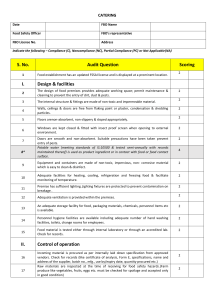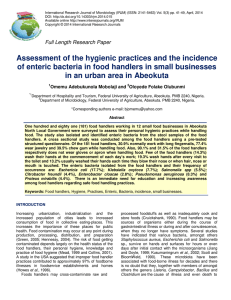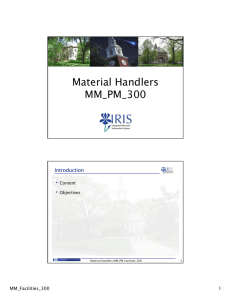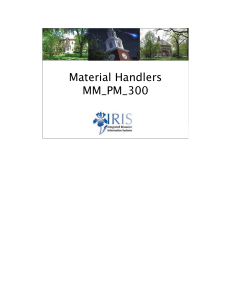Hygiene Policy For Hospital Food Preparation Areas
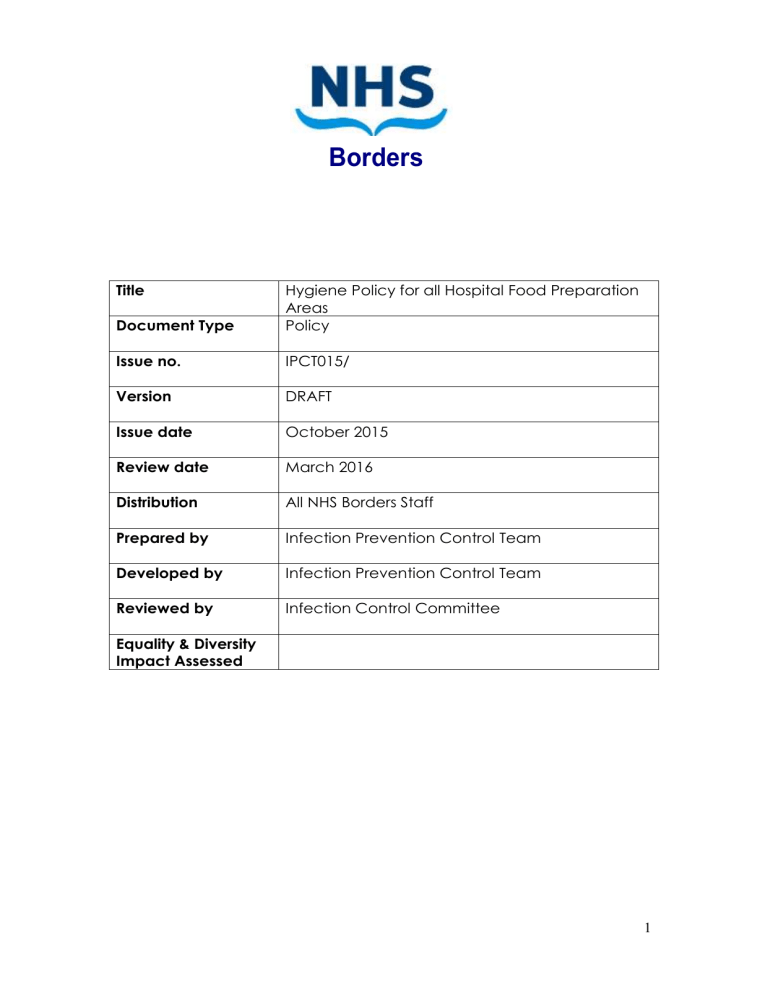
Title
Document Type
Issue no.
Version
Issue date
Review date
Distribution
Prepared by
Developed by
Reviewed by
Equality & Diversity
Impact Assessed
Borders
Hygiene Policy for all Hospital Food Preparation
Areas
Policy
IPCT015/
DRAFT
October 2015
March 2016
All NHS Borders Staff
Infection Prevention Control Team
Infection Prevention Control Team
Infection Control Committee
1
HOSPITAL FOOD PREPARATION AREAS: HYGIENE
POLICY
Aim: Food is prepared in a safe manner to prevent food related illnesses
Every year thousands of people suffer from food-borne illness. A few, especially the very young, the elderly or the infirm will die. Many of our patients are particularly at risk. Healthcare staff must provide a high standard of food hygiene to ensure that food poisoning is prevented.
All food handlers in healthcare premises must be provided with sufficient knowledge and training to ensure that their work methods minimise the risks of a food poisoning outbreak.
The training currently available is the Royal Environmental Health
Institute of Scotland (REHIS) Elementary Food Hygiene Certificate
Course held at the Borders General Hospital and presented by catering department.
Standards
The application of Hazard Analysis Critical Control Point (HACCP) is a legal requirement and therefore all food handlers within NHS Borders must be able to identify all steps in their activities which are critical to ensuring food safety and to ensure that adequate safety procedures are identified, implemented, maintained and reviewed on the following principles:
Analysing the potential food hazards in their catering operation
Identifying the points in these operations where food hazards may occur
Deciding which of the points identified are critical to food safety:
“the critical points”
Identifying and implementing effective control and monitoring procedures at those critical control points
Reviewing the analysis of food hazards, the critical control points and the control and monitoring procedures periodically.
The main purpose of such controls is to eradicate, as far as possible, the likelihood of food poisoning occurring as a result of improper handling of food.
2
One way to minimise this risk is to identify the ten most common risks of food poisoning and to ensure that they do not occur in our food premises.
For further information or advice on HACCP please contact the
Catering Manager at BGH.
The ten main risk factors for food poisoning
1.
Food prepared too far in advance and stored at room temperature, i.e. not under refrigeration.
2.
Cooling food too slowly before refrigeration.
3.
Not reheating food to high enough temperatures to destroy food poisoning bacteria.
4.
The use of cooked food contaminated with food poisoning bacteria.
5.
Undercooking.
6.
Not thawing frozen poultry for sufficient time.
7.
Cross-contamination from raw food to cooked food.
8.
Storing hot food below 63 C.
9.
Infected food handlers.
10.
Use of leftovers.
Personal hygiene
A high standard of personal hygiene is very important to prevent the food handler contaminating food. To prevent contamination, the food handler must ensure that:
Smoking is prohibited in any room in which food is prepared or stored
3
Food handlers must wash their hands regularly throughout the working day, and especially: o after visiting the toilet o on entering and re-entering the food room o between handling raw and cooked food o after eating, smoking, coughing, sneezing or blowing their nose o after handling waste food or refuse o after handling cleaning chemicals
Fingernails should be kept short and clean. Nail varnish may contaminate food and therefore should not be used. False nails must not be worn
Food handlers should not eat sweets, chew gum, taste food with their fingers or unwashed spoons or blow on china or glass to polish it
Cuts, spots and sores should be completely covered by a waterproof dressing (colour blue) available from your place of work
Food handlers should not wear earrings, watches, jewelled rings or brooches
A clean blue disposable apron should be worn when preparing, cooking or serving food
Clean protective clothing must be worn at the commencement of each working day and replaced more frequently should heavy soiling occur. Under no circumstances should outdoor clothing and personal effects be brought into food rooms.
Cleaning
The maintenance of high standards of cleanliness in all areas is given a high priority by NHS Borders, particularly in areas in which food is handled.
Cleaning schedules must clearly outline the frequency which cleaning is to be carried out, the materials to be used including chemicals, the method to be used and the standards to be achieved. It is, therefore essential that personnel who are asked to carry out such tasks are made aware of the content of the cleaning schedule for their area.
4
The level of cleanliness will be monitored daily by the Nurse in Charge or General Services Supervisor responsible for a particular area.
It will be the responsibility of the Charge Nurse or General Services
Supervisor to check that Kitchen Audits are being completed monthly, and to check periodically that the standards of cleanliness highlighted in the cleaning schedules are being met.
Pest control
Food Handlers discovering pests or pest damage should report to management immediately and get expert advice urgently by contacting Estates Department, who will call in specialists if necessary.
Common pests include insects, flies, wasps, cockroaches, birds, mainly feral pigeons and sparrows, and rodents.
Report sightings of pests to management immediately
Reasons for controlling pests include:
the prevention of the spread of disease
the prevention of wastage of food
the prevention of damage (fires and flooding caused by gnawing electric cables or pipes)
to comply with the law
Good housekeeping
To reduce the risk of infestation, ensure that:
Premises and refuse areas are kept in a clean and tidy condition.
Lids are always kept on waste bins, which should be washed after emptying, together with the surrounding area. Waste must not be allowed to accumulate
Food on display or awaiting preparation is always kept covered
Spills are cleared away promptly
Food is stored off the floor and clear of walls to facilitate regular inspection. Stock should be checked regularly and damaged stock removed
Food is stored in pest/ rodent-proof containers and lids are always replaced
All deliveries of raw materials, packaging and laundry are checked to ensure their freedom from infestation
5
Drains are kept clean and in good condition, a water trap is always maintained and gullies have tight-fitting metal grills
Vegetation covering the immediate outside access to the food premises should be removed
Temperature control
Food must be delivered, stored, cooked and served at the correct temperatures to ensure the minimum risk of food poisoning. At various
“critical points” the temperature of the food must be monitored and recorded, to ensure the maintenance of standards.
Digital Probe Thermometers must be used where a built in device is not supplied.
Delivery
When testing incoming high risk food the points to bear in mind are that the temperature immediately below the surface of the food (not wrappings) should be taken as well as core temperature. The higher of the two temperatures should be recorded on the monitoring sheet.
Refrigerator temperatures (1°C - 4°C,)
Routine monitoring of fridge units will be taken minimum twice daily by using the fridge thermometer provide or built in display. [see also
WARD REFRIGERATORS: GUIDELINES FOR USE]
Freezer temperatures (-18°C)
Where freezers have their own built-in temperature recording devices these will be recorded minimum twice daily. Probe thermometers should be used once a week to verify these results. When the probe is used its use should be highlighted in the remarks column of the temperature monitoring sheet.
FOR DAY UNITS:
Contact Catering Manager, Borders General Hospital for advice concerning any aspect of the Food Hygiene Policy
6
